Sonic Innovations FLIP1 Flip Rite BTE User Manual User Guide english
Sonic Innovations, Inc. Flip Rite BTE User Guide english
User Guide english
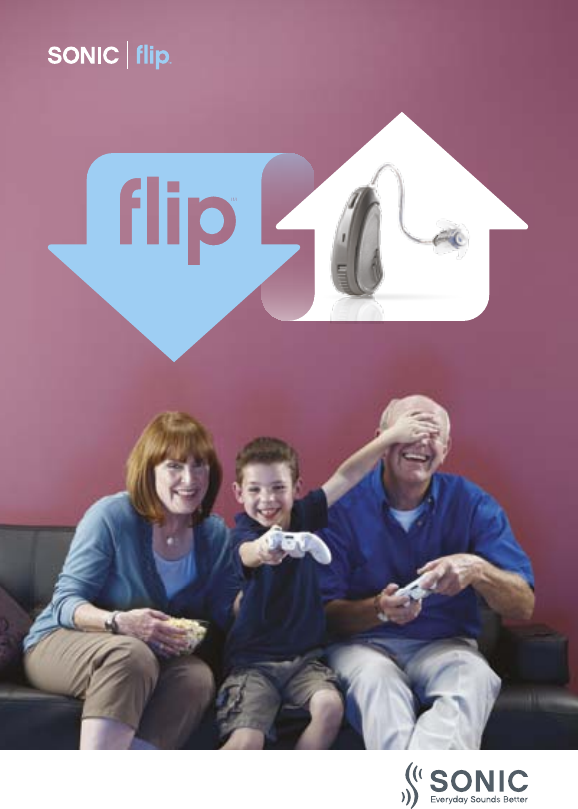
01
flip miniRIC
from Sonic
Flip User Guide

03
Hearing Instrument Serial Number:
Left Right
Hearing Instrument Model:
Left Right
Battery Size: 13A
Listening Listening
Program # Environment
1
2
3
4
Right & Left Instruments Synchronized:
r Active r Inactive
Program Button:
Program Change: r Right r Left
Program Button Mute: r Right r Left
Disabled: r Right r Left
Preferred Telephone Ear:
r Right Ear r Left Ear r Either Ear
Non-Telephone Ear:
r No Change
r Softer when telephone is in use
r Mutes when telephone is in use
FLIP · USER GUIDE

04
Table of Contents
Congratulations On Your Purchase! 07
General Warnings and Safety Guidelines 08
Hearing Expectations 12
Your Flip miniRIC Hearing Instrument 14
Turning Your Hearing Instrument On and Off 16
Putting ON Your Hearing Instrument 18
Taking OFF Your Hearing Instrument 19
Changing the Volume 20
Changing the Programs 22
Using the Telephone 24
Changing the Battery 28
Audible Indicators 32
Data Logging and Learning 33
Caring for Your Hearing Instruments 34
SONIC · FLIP

05
The Receiver Unit and Sound Dome 36
Changing the Sound Dome 37
Replacing the Wax Guard 38
Operating Your Flip with the RC-P Remote Control 39
Operating Your Flip with the SoundGate
Communication Device 40
Environmental Protection 41
Product Approval, Markings and Compliance 42
Cell Phone and Hearing Instrument Compatibility 44
Warranty and Repairs 46
Common Problems and Solutions 48
Compliance with Requirements for Europe 52
Compliance with Radio Communications
Requirements for the USA and Canada 53
Service 56
FLIP · USER GUIDE
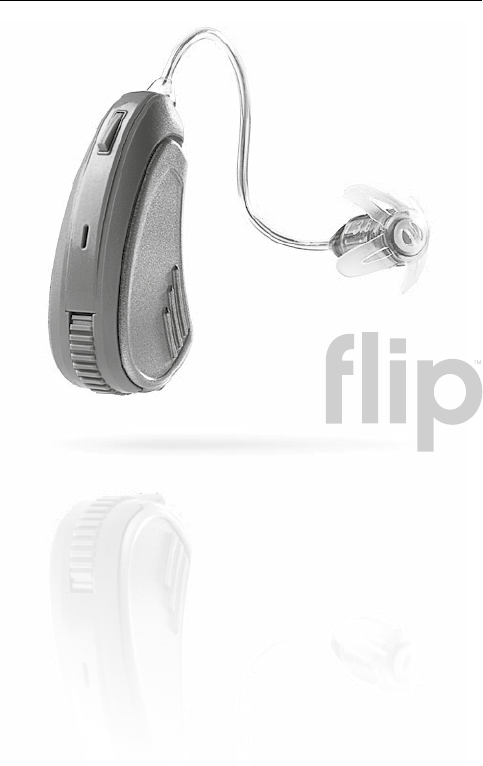
06 SONIC · FLIP

07
Congratulations On Your Purchase!
With a little practice, you will soon be on
your way to better hearing. Your hearing
instrument has been programmed to fit
your hearing and communication needs.
Please read the entire contents of this booklet
before using your hearing instruments. It contains
instructions and important information about the
use and handling of your hearing instruments and
batteries. With proper use and care, your hearing
instrument will improve your connection with the
world around you.
FLIP · USER GUIDE

08
General Warnings and Safety Guidelines
Familiarize yourself completely with the following
general warnings and safety guidelines before using
your hearing instruments:
· Hearing instruments and batteries can be dangerous
if swallowed or improperly used. Such actions
can result in severe injury, permanent hearing loss
or even fatality.
· Hearing instruments should be used only as
directed and adjusted by your trained hearing care
provider. Misuse or improper adjustments can
result in sudden and permanent hearing loss.
· Hearing instruments will not restore normal hearing
or prevent hearing loss resulting from organic
conditions.
· Never allow others to wear your hearing instruments.
They are adjusted for your hearing requirements and
may permanently damage another person’s hearing.
· Avoid wearing your hearing instrument while playing
contact sports (e.g. rugby, football etc.), since a strike
to the ear could be harmful.
SONIC · FLIP

09
· Be aware that use of a hearing instrument may cause
excess earwax to build up in the ear canal which may
require removal by a trained medical professional.
· Clean your hearing instruments and their parts on
a regular basis as recommended. Micro-organisms
from unclean instruments may cause skin irritations.
· In rare cases, a hearing instrument or earmold may
cause a discharge from the ear or allergic reaction.
See a physician immediately if these conditions occur.
· An earmold is a custom-made product. If you
experience discomfort or irritation of your ear, please
see your hearing care provider immediately for
modification of the earmold.
· Hearing instruments, their parts and batteries should
be kept out of reach of infants, children and anyone
who might swallow these items or otherwise cause
themselves injury.
· Take care when changing and discarding batteries to
keep them out of reach of infants, children, persons
of mental incapacity or pets.
· Be careful with leaking battery liquid, as it is a
hazardous substance.
FLIP · USER GUIDE

10
· Never attempt to recharge non-rechargeable
batteries.
· Never put your hearing instrument or batteries
in your mouth, as they could easily be swallowed.
· Keep batteries away from medications, since they
can easily be mistaken for pills.
· In the event that a battery or hearing instrument
is swallowed, see a doctor immediately.
· Be aware of the possibility that your hearing
instruments may stop functioning without notice.
Keep this in mind while you circulate in traffic
or otherwise depend on warning sounds.
· Traffic or other warning sounds may also be
reduced in level by a directional microphone when
these sounds are coming from behind you.
· Never insert cleaning tools into the microphone
inlet or deeply into the sound outlet. This could
damage the hearing instruments.
SONIC · FLIP

11
Caution!
Warning to Hearing Care Provider and Patient.
Special care should be taken when fitting and
using a hearing instrument with maximum
sound pressure capability in excess of 132 dB
SPL (IEC 711) since there may be a risk of
impairing the remaining hearing of the patient.
FLIP · USER GUIDE

12
Hearing Expectations
Set Appropriate Expectations
It is important that you have the right expectations
regarding your hearing instruments. Hearing
instruments will give you better hearing, but they
are not a cure for hearing loss.
People whose expectations are too high (“I thought
they would make my hearing normal”) are likely to
be disappointed and may give up.
Hearing Instruments Can:
· Help you hear and understand better in most
situations.
· Allow you to participate more in group situations
and meetings.
Hearing Instruments Cannot:
· Give you normal hearing.
Hearing Instruments May Not:
· Let you hear very soft sounds.
· Block ALL background noises – especially in noisy
situations. Even people without hearing loss
may have difficulty hearing in the presence of
background noise.
SONIC · FLIP

13
Be Patient
Unlike eyeglasses which correct your vision as soon
as you first put them on, hearing instruments need
some time for proper adjustment. It may take several
weeks or months to completely adjust to your hearing
instruments, so try to be patient. Initially, try different
listening situations, such as one-on-one conversations
with family and friends and conversations with two
or three people at home or in quiet settings. Also, try
having conversations in noisier places like parties,
restaurants, meetings, and outdoors. Do not forget
that some situations are simply too noisy in general –
even for people without hearing loss. So do not get
discouraged.
Consistent use of your hearing instrument is strongly
recommended. In most cases, infrequent use does not
allow you to obtain the full benefit from your device.
The use of a hearing instrument is only a part of
total hearing rehabilitation, and may need to be
supplemented by auditory training and instruction
in speech reading.
FLIP · USER GUIDE
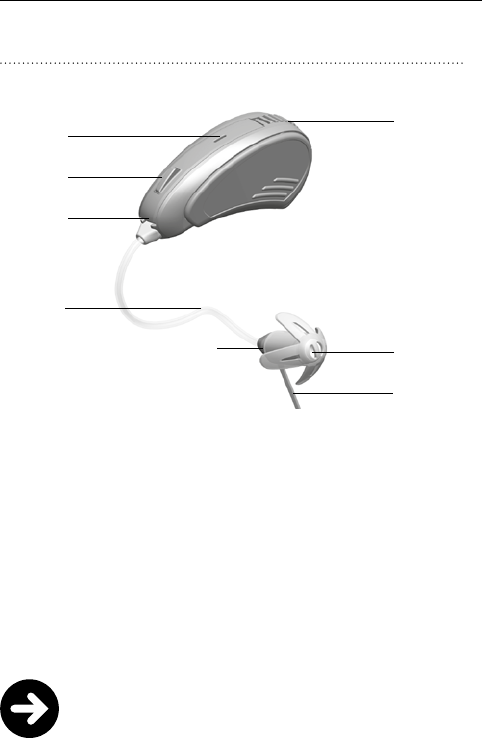
14
Your Flip miniRIC Hearing Instrument
Note! Never attempt to re-form the receiver
unit or insert anything directly into it.
1
2
3
4
5
7
8
6
1 Rear Microphone
2 Program Button
3 Front Microphone
4 Receiver Tube
5 Volume Control Wheel
6 Receiver
7 Sound Outlet
8 Retention Lock
SONIC · FLIP
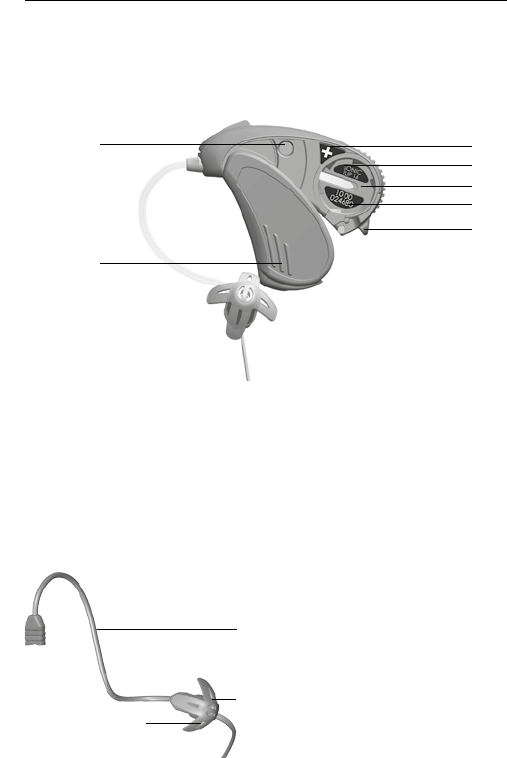
15
Left/Right Ear Marking
A color marking indicator can help you distinguish left
and right instruments.
Receiver Unit
1
2
4
5
6
7
1 Left/Right
(Left=Blue, Right=Red)
2 Battery Door
3 Battery positive
4 Manufacturer/Model
5 Battery Compartment
6 Serial Number
7 Battery Door Catch
3
Receiver Housing
Receiver Tube
Sound Dome
FLIP · USER GUIDE
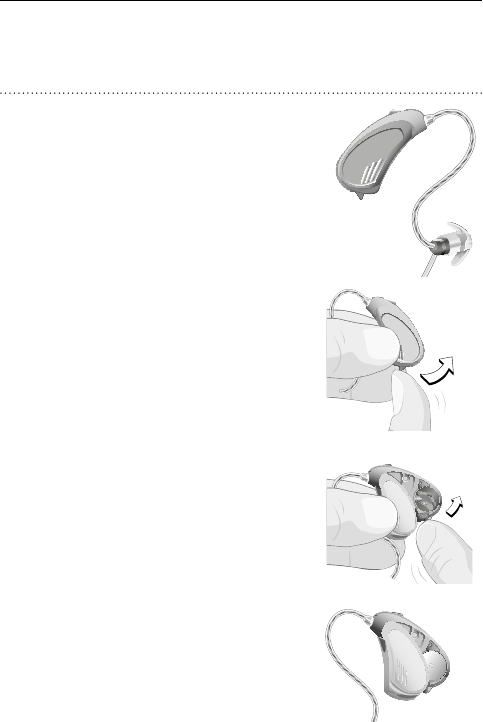
16
Turning Your Hearing Instrument
On and Off
Before turning off your hearing
instrument, wipe away any moisture
with a soft cloth.
To turn off your hearing instrument,
open the battery door slightly:
· Grasp the battery door
with your thumb and
index finger.
· With your other thumb,
firmly pull upwards
on the battery door catch.
· The instrument turns off
as soon as any part
of the battery compartment
is visible.
· Fully close the door to turn
the hearing instrument back on.
FL_ILLU_MNR_Basic
FL_ILLU_MNR_BatteryDoorOpening1_BW_HI
FL_ILLU_MNR_BatteryDoorOpening2_BW_HI
FL_ILLU_MNR_InstrumentOFF_BW_HI
SONIC · FLIP

17
Your hearing instrument may be programmed
to alert you with a beep when it is turned on. Your
hearing care provider will tell you if this feature
is enabled. Your hearing instrument may also have
a “power on” delay. This allows you to insert the
instrument before it is fully active.
To prolong battery life, turn off your hearing
instrument when not in use.
FLIP · USER GUIDE
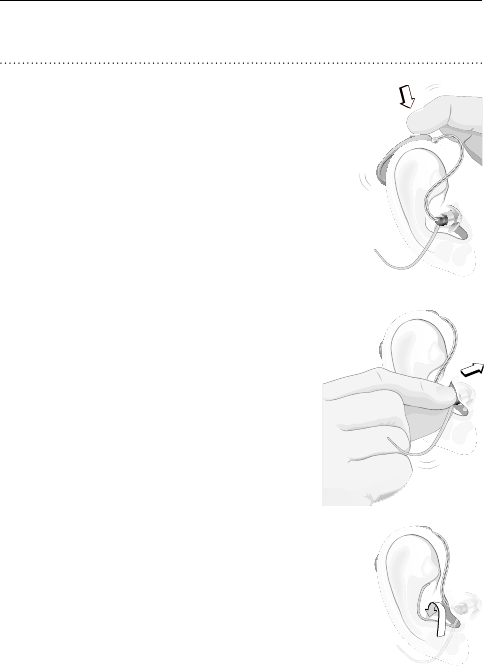
18
Putting ON Your Hearing Instrument
· First, position the hearing instrument
over the top of your ear.
· Grasp the bend of the receiver
tube and gently push the sound
dome or earmold into your
ear canal until the tube rests
against the side of your head.
When the sound dome is placed
appropriately, you should not
be able to see the receiver unit
sticking out when you look
directly into a mirror.
If the sound tube is sticking out
from your ear, insert the dome
or earmold further.
· Use your finger to push
the retention lock comfortably
into the bowl of your ear.
FL_ILLU_MNR_PutHearingAidonEar1_BW_HI
FL_ILLU_MNR_PutHearingAidonEar3_BW_HI
FL_ILLU_MNR_PutHearingAidonEar2_BW_HI
SONIC · FLIP

19
Taking OFF Your Hearing Instrument
To remove your hearing instrument, hold the receiver
unit and gently pull the sound dome or earmold out of
your ear canal.
· Lift the hearing instrument case from behind
your ear.
· Open the battery compartment to turn off the device.
Important! Do not remove the instrument by
pulling on the hearing instrument case. This
might disconnect the device from the receiver
unit.
Should the sound dome become separated from the
receiver unit and remain lodged in your ear canal after
removal of the hearing instrument, do not attempt to
remove the sound dome yourself. Seek immediate care
from your hearing care provider or physician.
FLIP · USER GUIDE

20
Changing the Volume
Your hearing instruments are programmed to be at
a comfortable volume level for your hearing loss. They
are designed to automatically adjust to changes in
the sound environment. You should only need to
make small volume changes to get a natural and
comfortable sound.
In order to make these small changes, your hearing
instrument has a volume control that allows you to
turn up or turn down the volume when needed.
Rotate the volume control wheel up to turn up the
volume as needed. If you need to lower the volume,
slowly turn the volume control wheel down. Your
hearing instrument may play a series of beeps when
you have reached the maximum or minimum volume.
You may also hear soft clicks as you turn the wheel,
indicating small changes in your instrument’s volume
settings.
Rotate up to
increase volume
Rotate down to
decrease volume
Volume
Control
Wheel
SONIC · FLIP

21
Important! If the volume of your hearing
instrument is too loud or soft when the volume
control is all the way up, your hearing care
provider may need to make changes to your
listening program.
Note! Your hearing instruments automatically
return to a pre-set loudness level when
they are powered on, when the battery is low,
or when the program is changed. If you find
that you frequently need to turn the volume
up or down, your hearing care provider may
need to adjust your settings.
FLIP · USER GUIDE

22
Changing the Programs
Your hearing instrument can be configured with
multiple listening programs. Please see inside
the front cover of this User Guide to find out which
program(s) have been configured by your hearing
care provider. You can change programs as follows:
Program Button
A long press (about 2 seconds) on the program button
will cause the listening program to change. You will
hear the same number of beeps as the program you
are in each time you push the button. When you
turn the hearing instrument off and then on, it will
automatically return to your default listening program
(program 1).
RC-P Remote Control or SoundGate
(optional accessories)
The listening program can be changed with either
of these devices. Please see pages 39 and 40 for
instructions.
SONIC · FLIP
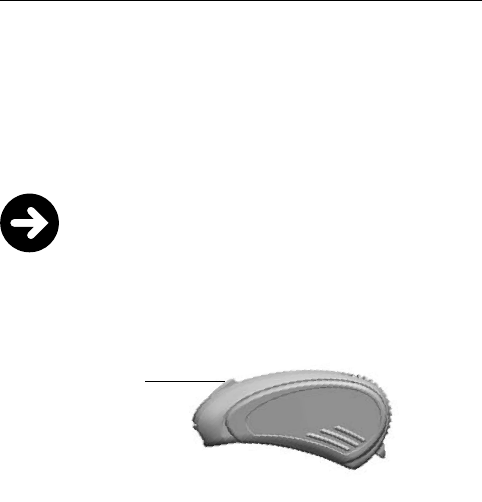
23
Program Button Mute
A longer press (about 5 seconds) on the program
button will cause the hearing instrument to mute, no
matter which program you are in. Press the button
again to un-mute the device.
Note! Your hearing care provider can custom-
ize the behavior of the program button. Please
see inside the front cover to find out how your
control may have been configured.
Program Button
FLIP · USER GUIDE

24
Using the Telephone
Phonecoil
Your hearing instrument has a Phonecoil option that
has the ability to pick up just the sounds coming
from a hearing instrument compatible telephone. Your
hearing care provider can program your hearing
instrument to take advantage of this option. Refer to
the chart on the inside cover of this User Guide to
determine the listening program that uses the Phone-
coil feature. When you have moved to the Phonecoil/
telephone program, place the telephone handset
lightly against your ear. Adjust the handset slightly
up and/or back to find the position that gives the best
sound.
Note! Not all telephones are compatible with
the Phonecoil in your hearing instruments.
Auto Telephone
Your hearing instrument has an Auto Telephone
feature. When the hearing instrument is close to a
telephone receiver, the Auto Telephone will activate
your telephone listening program. When you end
your conversation, the hearing instrument will auto-
matically return to the previous listening program.
SONIC · FLIP

25
Your hearing care provider can configure your hear-
ing instruments to allow answering the phone on both
ears or on your preferred ear.
Flip100 Only
If you have a preferred ear, the hearing instrument on
the opposite side can be programmed to sound softer
or mute when the Auto Telephone is active. Refer
to the information inside the front cover to find out
how your hearing instruments are configured.
Note! Some telephones may need a special
magnet added to help engage the Auto Tele-
phone feature. To mount the magnet onto your
telephone, please follow the instructions
included in the magnet’s packaging or contact
your hearing care provider.
FLIP · USER GUIDE

26
Phone Usage Tips
Hold the receiver close to the microphone inlet of your
hearing instrument. If this causes whistling, move the
receiver away a small distance.
· If voices over the telephone are too soft or back-
ground noise is a problem, use your Phonecoil
program. Be aware that not all phones are
Phonecoil compatible.
· Mobile phones may cause interference with
the Phonecoil. In this case, the microphone mode
will give a better result.
· Before purchasing a mobile phone, test it with
your hearing instrument.
· People with a greater degree of hearing loss
may need a volume control on the telephone.
Note! If your hearing instrument has been
configured without these options, select
the program that is best for you when using
the telephone. Then position the phone
lightly against your ear as described above.
SONIC · FLIP

27
Magnet Warning
Keep magnets out of reach of children and pets.
If a magnet is swallowed, see a doctor immediately.
Do not wear the magnet in a breast pocket and keep
it 1 ft (30 cm) away from pacemakers and other active
implants.
Use the magnet on the opposite side from active
implantable devices.
Keep the magnet 1 ft (30 cm) away from credit cards
or other magnetically sensitive items.
FLIP · USER GUIDE

28
Changing the Battery
When the battery is low, your hearing instrument
will beep at regular intervals. You should be prepared
to replace the battery. The time until the hearing
instruments stop working depends on the battery type
and manufacturer. Mercury-free batteries generally
cause earlier warning beeps.
Change Batteries Regularly
When your battery needs to be changed you will hear
three beeps: a low tone, followed by a high tone and
another low tone. The exact battery life you experience
may vary, but you should expect approximately 238
hours of total hearing instrument use per battery.
Important! Never force the battery drawer
open or closed.
SONIC · FLIP
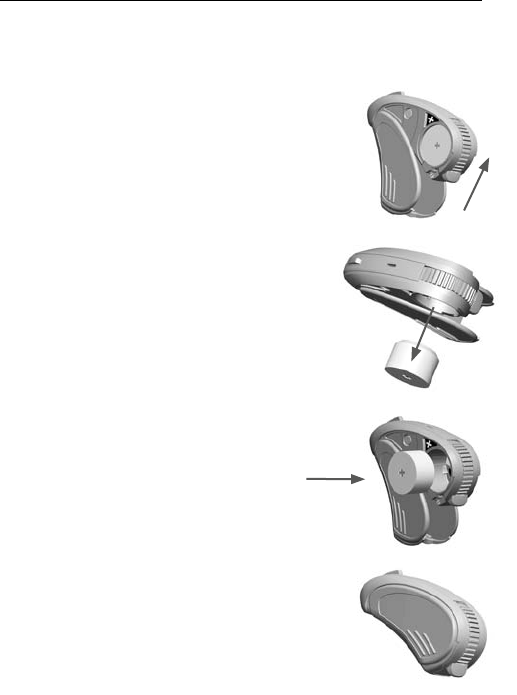
29
Remove the Old Battery
Before changing the battery, wipe away
any moisture with a soft cloth.
· Open the battery compartment fully,
by grasping the instrument and
by pulling upwards on the battery
door catch (see page 16).
· Turn the instrument on its side
and gently shake the battery
out into your hand. Be careful
not to lose the battery.
Insert a New Battery
· Remove the sticker from a
new battery. Place it into
the battery compartment
with the flat, smooth side
facing up (+ sign).
· Close the battery door
securely.
FLIP · USER GUIDE

30
Important Battery Information
· Battery life will vary with conditions of use
(for example, batteries will run down faster
in noisy environments).
· Always keep spare batteries on hand.
· A used battery should be replaced immediately.
· If you are not going to use your hearing instruments
for a few days, remove the batteries.
· Any moisture found on a battery should be wiped off
immediately with a soft cloth.
· Always remove zinc-air batteries before drying
your hearing instrument with a drying kit. Drying
out zinc-air batteries shortens their lifetime.
· Used batteries should be returned to your battery
supplier or hearing care provider for safe disposal.
· Never dispose of batteries by burning them.
They may explode and cause injury.
SONIC · FLIP

31
· Never dispose of batteries with household waste.
They cause environmental pollution.
· Batteries can be harmful if swallowed. Keep batteries
out of the reach of pets and small children. In case of
ingestion, contact your physician immediately.
FLIP · USER GUIDE

32
Audible Indicators
*Audible Indicators can be heard in the opposite hearing instrument
if the Volume Control and Program Change Synchronize feature is
activated in the fitting software. Refer to the Owner Information in the
inside cover to see how your devices are customized.
Event Tone Description
Start Up Delay Configurable short,
medium or long delay before
amplification starts
Power On A sustained beep when
amplification starts
Listening
Program Change*
One to four single beeps;
Number of beeps matches
listening program position
Volume
Control Click*
Brief click to indicate wheel
is turning up or down
Volume Control
Limit*
Rapid double beep at both
maximum and minimum
volume ranges
Low Battery Three warning beeps in a
low-high-low pitch sequence
Power Down;
Dying Battery
A fast sequence of beeps
descending in pitch
SoundGate
Incoming call
Telephone ringing signal
SONIC · FLIP

33
Data Logging and Learning
Data Logging
The data log automatically stores information about
your use of your hearing instruments such as program
changes, hours of wear, etc. This information can be
used by your hearing care provider to adjust your
hearing instruments. If you do not want this feature
to be active, please ask your hearing care provider
to turn it off.
Data Learning (Flip100)
When data learning is operating, the hearing
instrument keeps track of how often and how much
you adjust the volume and “learns” your preferred
setting. This new setting can be made permanent
during your follow-up visit.
FLIP · USER GUIDE

34
Caring for Your Hearing Instruments
Healthy ears produce cerumen, a waxy substance that
can clog your hearing instruments. Please follow
these cleaning instructions to prevent wax build-up
and ensure optimal performance.
Every Night
· Check your hearing instruments for ear wax and wipe
them clean with a cloth or tissue.
· Use the cleaning tool provided to remove wax that
may have accumulated in the wax guard or vent
opening if you have a custom earmold.
· Open the battery door fully to allow air to circulate.
· A dry storage kit is recommended to remove any
moisture that may have accumulated in the hearing
instrument.
SONIC · FLIP

35
Avoid Heat, Humidity and Chemicals
· Do not expose your hearing instruments to extreme
heat by leaving them in the car, near a radiator, etc.
· Avoid exposing your hearing instruments to moisture
(e.g. steambaths, showers, heavy rain, etc.)
· Never attempt to dry your hearing instruments
with a hair dryer, microwave oven, etc.
· Remove your hearing instruments before applying
aftershave, hairspray, oils, perfume, mosquito
repellent, lotions, etc. Allow drying time before
wearing your hearing instruments.
· Protect your hearing instruments by keeping them
in the case when you are not wearing them.
· Consult your physician if excessive earwax, skin
irritation, or a foreign object prevents you from
wearing your hearing instrument.
FLIP · USER GUIDE

36
The Receiver Unit and Sound Dome
Never expose the receiver unit or sound dome to
water. It will damage the electronics of the hearing
instrument.
It is important that the receiver unit and the sound
dome fit correctly into your ear. If the receiver unit or
the sound dome irritates your ear in any way and
prevents you from wearing your hearing instrument,
please contact your hearing care provider.
It is recommended that you have your hearing care
provider change the sound domes for you when they
become stiff, brittle or unclean. If your hearing care
provider instructs you to change the sound domes
yourself, make sure that they are securely fastened
to the receiver unit before you insert them in your ear.
A failure to change the sound domes in accordance
with the following instructions could result in
personal injury.
Receiver Housing
Receiver Tube
Sound Dome
SONIC · FLIP
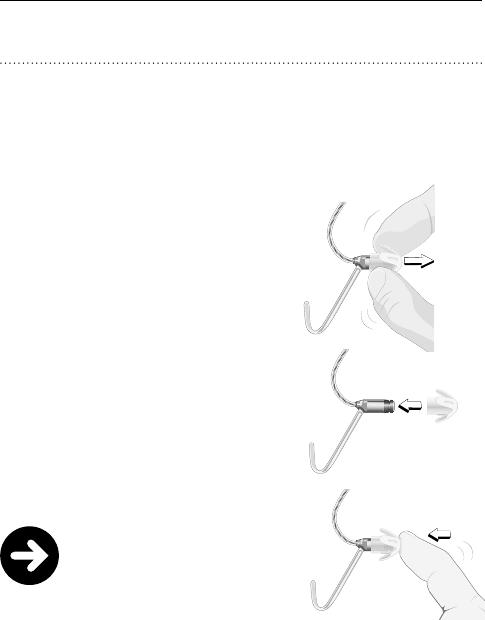
37
Changing the Sound Dome
The sound dome should be changed regularly. The
frequency of dome changes will depend on how fast
it loses pliability or ear wax builds up on the dome.
Spare domes can be obtained from your hearing
care provider.
· Remove the old dome
by pulling it off the end
of the receiver housing.
· With clean fingers, push
a new dome as far as
possible onto the receiver
housing. When attached
correctly, the dome should
touch the plastic ring
around the sound tube.
Caution! If the dome is
not securely attached
to the receiver, it could
fall off in your ear canal.
If this happens, please
see your medical practitioner.
FL_ILLU_MNR_Dome1_BW_HI
FL_ILLU_MNR_DomeAttaching1_BW_HI
FL_ILLU_MNR_DomeAttaching2_BW_HI
FLIP · USER GUIDE
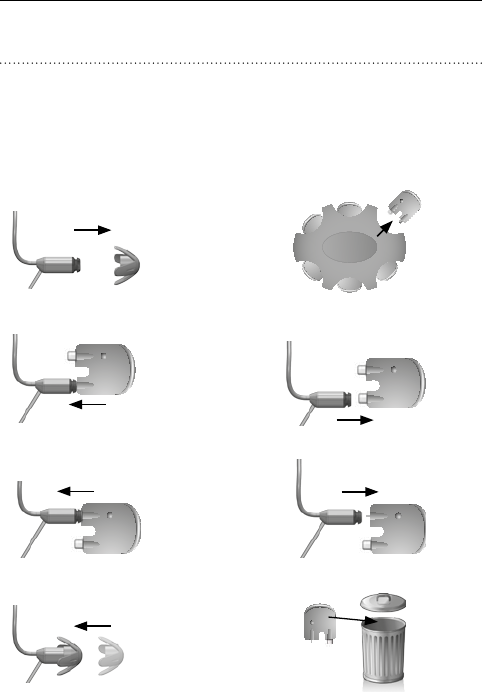
38
Replacing the Wax Guard
Your hearing instrument uses the NoWax system
to protect the hearing instrument from earwax.
Wax guards can either be replaced by you or by
your hearing care provider.
1
7
6
5
4
3
2
Remove the Dome Take a new removal tool
Insert the removal prong
into the old wax guard
Extract the old wax guard
Insert the new wax guard Pull out the removal tool
Replace the dome Discard the removal
tool and old wax guard
SONIC · FLIP
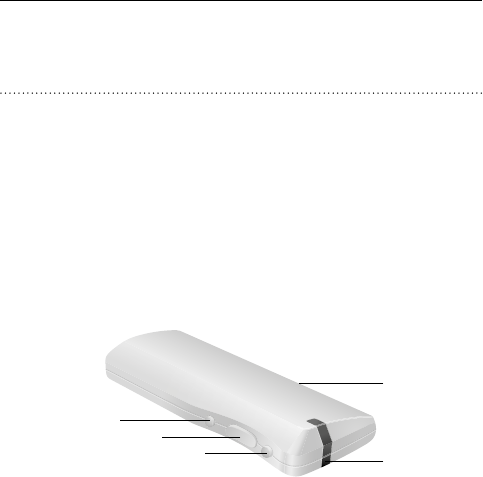
39
Operating Your Flip with the RC-P
Remote Control
Optional Accessory
If you have purchased a remote control, you can use
it to change listening programs, adjust the volume
level up and down, or mute the hearing instruments.
For complete operating instructions, please read the
separate RC-P Remote User Guide.
1 Program cycle button
2 Volume control
3 Mute button
4 Status light
5 Key lock
3
2
1
4
5
FLIP · USER GUIDE
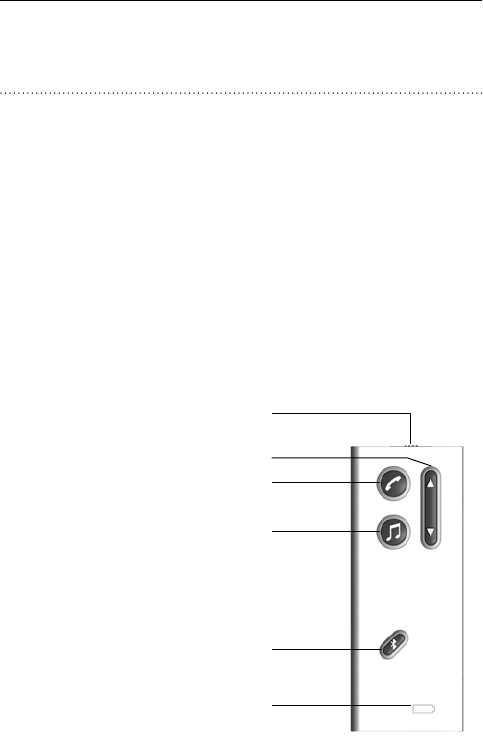
40
Operating Your Flip with the SoundGate
Communication Device
Optional Accessory
If you have purchased a SoundGate, you may use it
to perform basic functions such as listening to
program changes or volume adjustments. In addition,
the SoundGate serves as a link between your hearing
instruments and external sources such as music
players, cell phones, computers, etc.
For complete operating instructions, please read
the separate SoundGate User Guide.
1 Volume control
and program change
2 Phone
3 Music/Audio key
(e.g. MP3)
4 Bluetooth® key
5 Battery indicator
6 Key lock
1
2
3
4
6
5
SONIC · FLIP

41
Environmental Protection
Your hearing instruments contain electronic
components subject to the Directive 2002/96/EC on
waste electrical and electronic equipment (WEEE).
Help to protect the environment by not disposing
of your hearing instruments or batteries with your
unsorted household waste. Please recycle your
hearing instruments and batteries according
to your local regulations or return them to your
hearing care provider for disposal.
FLIP · USER GUIDE

42
Product Approval, Markings
and Compliance
All Sonic hearing instruments comply with internation-
al standards concerning electromagnetic compatibility.
Due to the limited space available on the hearing
instruments all relevant approval markings are found
in this document.
Electromagnetic Interference
Your hearing instrument has been thoroughly tested
for electromagnetic interference. However, some
products may emit electromagnetic energy causing
unforeseen interference with hearing instruments.
Examples include induction cooking appliances, shop
alarm systems, mobile phones, fax machines,
personal computers, X-rays, CT scans, etc.
Even though your hearing instruments are designed
to comply with the most stringent international
standards of electromagnetic compatibility, they
may emit electromagnetic energy that can cause
interference with other devices.
Your hearing instruments contain a radio transmit-
ter using short range magnetic induction technology
working at 3.84 MHz. The magnetic field strength
of the transmitter is <– 42 dBμA/m @ 10 m.
SONIC · FLIP

43
The electromagnetic emission from the radio system
is well below international limits for human exposure.
By comparison, the electromagnetic energy of the
hearing instruments is lower than that generated by
household items such as halogen lamps, computer
monitors, dishwashers etc.
FLIP · USER GUIDE

44
Cell Phone and Hearing Instrument
Compatibility
Some hearing instrument users have reported a
buzzing sound in their devices when they are using
cell phones, indicating that the cell phone and
hearing instrument may not be compatible.
The compatibility of a particular hearing instrument
and cell phone can be predicted by adding the rating
for the hearing instrument immunity to the rating
for the cell phone emissions (ANSI C63.19-2006
American National Standard Methods of Measurement
of Compatibility between Wireless Communication
Devices and Hearing Aids).
For example, the sum of a hearing instrument with
a rating of 2 (M2/T2) and a telephone with a rating of
3 (M3/T3) would result in a combined rating of 5.
According to the standard, any combined rating
that equals at least 5 would provide “normal use”;
a combined rating of 6 or greater would indicate “
excellent performance.”
SONIC · FLIP

45
The immunity of your Flip hearing instrument is
at least M2/T2. The equipment performance
measurements, categories and system classifications
are based upon the best information available but
Sonic Innovations cannot guarantee that all users
will be satisfied.
Note! The performance of individual hear-
ing instruments may vary with individual cell
phones. Please try this hearing instrument
with your cell phone or, if you are purchasing
a new phone, be sure to try it with your
hearing instrument prior to purchase. For
additional guidance, please ask your cell
phone provider for the booklet entitled
“Hearing Aid Compatibility with Digital
Wireless Cell Phones.“
FLIP · USER GUIDE

46
Warranty and Repairs
Your hearing instruments have a limited warranty,
covering defects in materials and workmanship. This
warranty covers the hearing instruments themselves,
but not accessories such as batteries, tubing, domes,
earmolds, etc.
This warranty is void if a defect is the result of misuse
or mistreatment. The warranty is also void if the hear-
ing instruments have been repaired by nonauthorized
service personnel.
Please review the warranty with your hearing care
provider and make sure that your warranty card is
completed correctly.
Note! Your hearing care provider may charge
a service fee for processing warranty repairs.
Accessories
Sonic offers a wide range of optional accessories that
may be purchased to enhance your hearing system.
Depending on hearing instrument type and local
regulations, the following accessories are available:
SONIC · FLIP

47
· RC-P Remote Control
· SoundGate communication device (for wireless
connection to cell phones, music players, etc.)
· TV Adapter (for wireless connection to your television
via the SoundGate)
· Phone Adapter (for wireless connection to your
landline phone via the SoundGate)
For further information on accessories please contact
your hearing care provider.
FLIP · USER GUIDE

48
Problem Possible cause Solution
Instrument
whistles
or squeals
Instrument not inserted correctly Re-insert instrument
Ear wax accumulation in ear canal Consult your hearing care provider or physician
Instrument may be too loose Consult your hearing care provider
Receiver unit may be split or
improperly connected
Consult your hearing care provider
No volume, level
too soft or
humming noise
Instrument may not be turned on Check that the battery door is closed completely
Battery may be dead or inserted
wrong way
Insert a fresh battery
Volume level too soft Increase volume level with control on instrument
or remote control or consult your hearing care pro-
vider
Ear wax accumulation in ear canal Consult your hearing care provider or physician
Battery contacts may be dirty
or corroded
Open and close the battery door several times
or clean the battery contacts carefully with
a dry Q-tip
Sound outlet may be blocked
or corroded
Check the tubing and earmold or dome
for moisture or wax blockage
Microphone sound inlet may
be blocked
Consult your hearing care provider, do not try
to clean this yourself
Your hearing loss may have
increased
Consult your hearing care provider
Common Problems and Solutions
SONIC · FLIP

49
Problem Possible cause Solution
Instrument
whistles
or squeals
Instrument not inserted correctly Re-insert instrument
Ear wax accumulation in ear canal Consult your hearing care provider or physician
Instrument may be too loose Consult your hearing care provider
Receiver unit may be split or
improperly connected
Consult your hearing care provider
No volume, level
too soft or
humming noise
Instrument may not be turned on Check that the battery door is closed completely
Battery may be dead or inserted
wrong way
Insert a fresh battery
Volume level too soft Increase volume level with control on instrument
or remote control or consult your hearing care pro-
vider
Ear wax accumulation in ear canal Consult your hearing care provider or physician
Battery contacts may be dirty
or corroded
Open and close the battery door several times
or clean the battery contacts carefully with
a dry Q-tip
Sound outlet may be blocked
or corroded
Check the tubing and earmold or dome
for moisture or wax blockage
Microphone sound inlet may
be blocked
Consult your hearing care provider, do not try
to clean this yourself
Your hearing loss may have
increased
Consult your hearing care provider
FLIP · USER GUIDE

50
Problem Possible cause Solution
Whirring noise,
fading, weak or
motor-boating
sounds
Battery contacts may be dirty
or corroded
Open and close the battery door several times
or clean the battery contacts with a dry Q-tip
Moisture in hearing instrument Place hearing instrument in Dry-Instrument pack.
Remove battery first. Consult your hearing care
provider
Low battery Insert a fresh battery
Instrument
switches from
ON to OFF
periodically
Low battery Insert a fresh battery
SONIC · FLIP

51
Problem Possible cause Solution
Whirring noise,
fading, weak or
motor-boating
sounds
Battery contacts may be dirty
or corroded
Open and close the battery door several times
or clean the battery contacts with a dry Q-tip
Moisture in hearing instrument Place hearing instrument in Dry-Instrument pack.
Remove battery first. Consult your hearing care
provider
Low battery Insert a fresh battery
Instrument
switches from
ON to OFF
periodically
Low battery Insert a fresh battery
FLIP · USER GUIDE

52
Compliance with Requirements
for Europe
This device is in conformance with the requirements
of the Directive 93/42/EEC of the Council of the
European Communities concerning medical devices,
MDD. This is certified by applying this marking.
This device also complies with the essential
requirements of the Directive 1999/5/EC of the
European Parliament on radio equipment and
telecommunications terminal equipment, R&TTE.
It operates as an inductive application in a
harmonized frequency band according to the
Commission Decision 2008/432/EC and may be
used in all member states of the EU and EFTA.
This is certified by applying this marking.
Declarations of conformity are available at:
Sonic Innovations, Inc.
2501 Cottontail Lane
Somerset, NJ 08873
SONIC · FLIP

53
Compliance with Radio Communications
Requirements for the USA and Canada
Sonic Innovations, Inc.
Flip hearing instrument models FL100; FL80; FL60
FCC ID ZTOFLIP1
IC: 9799A-FLIP1
This device complies with part 15 of the FCC Rules
and RSS-210 of Industry Canada. Operation is
subject to the following two conditions:
(1) This device may not cause harmful interference,
and
(2) This device must accept any interference received,
including interference that may cause undesired
operation.
This Class B digital apparatus complies with
Canadian ICES-003.
Note! This equipment has been tested and
found to comply with the limits for a Class B
digital device, pursuant to part 15 of the FCC
Rules.
FLIP · USER GUIDE

54
These limits are designed to provide reasonable
protection against harmful interference in a residential
installation.
This equipment generates, uses, and can radiate radio
frequency energy and, if not installed and used in
accordance with the instructions, may cause harmful
interference to radio communications. However, there
is no guarantee that interference will not occur in a
particular installation.
If this equipment does cause harmful interference
to radio or television reception, which can be
determined by turning the equipment off and on,
the user is encouraged to try to correct the
interference by one or more of the following
measures:
· Reorient or relocate the receiving antenna.
· Increase the separation between the equipment and
receiver.
· Connect the equipment into an outlet on a
circuit different from that to which the receiver
is connected.
· Consult the dealer or an experienced radio/TV
technician for help.
SONIC · FLIP

55
Caution! Changes or modifications not
expressly approved by Sonic could void the
user’s authority to operate the equipment.
FLIP · USER GUIDE

56
Service
If none of the actions listed in the previous pages
correct a problem you may have with your hearing
instrument, contact your authorized Sonic service
representative. Do not attempt to service your
hearing instruments yourself or your warranty
may be voided.
Place stamp with dispenser name and address here:
SONIC · FLIP

57
Notes
FLIP · USER GUIDE

58
Notes
SONIC · FLIP

World Headquarters
Sonic Innovations, Inc.
2501 Cottontail Lane
Somerset, NJ 08873 USA
+1 888 423 7834
Canada
Sonic Innovations Canada Ltd.
920 Industriel Blvd
Terrebonne, Quebec
J6Y 1X1 Canada
+1 800 667 7664
Australia
Sonic Innovations Pty Ltd
3 Unley Road
Parkside, SA 5063
Australia
800 807 022 (Within Australia)
+61 8 8373 5722 (Outside Australia)
11.11/120249
International
Sonic AG
Morgenstrasse 131B
3018 Bern, Switzerland
+41 31 560 21 21
www.sonici.com
France
Sonic France
37/39, rue J.B. Charcot – BP 314
92402 Courbevoie Cedex, France
+33 1 41 88 00 80
Sonic AG
Morgenstrasse 131B
3018 Bern, Switzerland
+41 31 560 21 21
Sonic Innovations, Inc.
2501 Cottontail Lane
Somerset, NJ 08873 USA
+1 888 423 7834